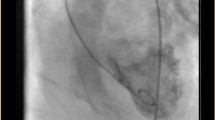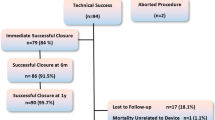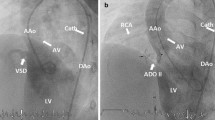Abstract
This study presents technique and initial experience of retrograde deployment of the Amplatzer muscular ventricular septal defect occluder (AmVSDo) for closure of muscular ventricular septal defects (VSDs). The conventional technique for closing muscular VSDs involves the creation of an arteriovenous guidewire circuit and use of a transvenous approach for device deployment. Seven patients aged 2.2–15 years underwent transcatheter closure of a muscular VSD using the retrograde approach without making the arteriovenous wire circuit. Mean fluoroscopy and procedural times were compared to those previously reported in publications describing the use of the antegrade approach. Unpaired Student’s t-test was used to compare the two parameters in two groups. Our technique was successful in all patients reported. The mean fluoroscopy time in the retrograde versus the antegrade group was 33.8 ± 20.9 and 41.9 ± 6.2 minutes, respectively (not significant), and the mean procedural time in the two groups was 91.1 ± 22.1 and 114 ± 33.9 minutes respectively (p = 0.025). No complications were noted.
We suggest that some muscular VSDs can be safely closed retrogradely without the use of an arteriovenous loop, thus reducing the radiation exposure and also the cost of the procedure. Further studies are needed to confirm this initial experience.




Similar content being viewed by others
References
Amin Z, Danford DA, Lof J, Duncan KF, Froemming S (2004) Intraoperative device closure of perimemberanous ventricular septal defects without bypass: preliminary results with perventricular technique. Thorac Cardiovasc Surg 127:234–241
Amin Z, Gu X, Berry JM, et al. (1999) New device for closure of muscular ventricular septal defects in a canine model. Circulation 100:320–328
Anderson RH, Becker AE, Tynan M (1986) Description of ventricular septal defects or how long is a piece of string? Int J Cardiol 13:267–268
Arora R, Trehan V, Kumar A, Karla GS, Nigam M (2003) Transcatheter closure of congenital ventricular septal defects: Experience with various devices. J Interven Cardiol 16:83–91
Arora R, Trehan V, Thakur AK, et al. (2004) Transcatheter closure of congenital muscular ventricular septal defect. J Interven Cardiol 17:109–115
Chessa M, Carminati M, Cao QL, et al. (2002) Transcatheter closure of congenital and acquired muscular ventricular septal defects using the Amplatzer device. J Invasive Cardiol 14:322–327
Griffiths SP, Turi GK, Ellis K, et al. (1981) Muscular ventricular septal defects repaired with left ventriculotomy. Am J Cardiol 48:877–886
Hijazi ZM, Hakim F, Al-Fadley F, Abdelhamid J, Cao Q-L (2000) Transcatheter closure of single muscular ventricular septal defects using the Amplatzer muscular VSD. Cathet Cardiovasc Interven 49:167–172
Holzer R, Balzer D, Cao Q-L, et al. (2004) Device closure of muscular ventricular septal defects using Amplatzer muscular ventricular septal defect occluder: immediate and mid-term results of a U.S. registry. J Am Coll Cardiol 43:1257–1263
Janokar S, Goh T, Wilkinson J (1999) Transcatheter closure of ventricular septal defects using the Rashkind device: initial experience. Cathet Cardiovasc Interv 46:43–48
Latiff HA, Alwi M, Kandhavel G, Samion H, Zambahari R (1999) Transcatheter closure of multiple muscular ventricular septal defects using Gianturco coils. Ann Thorac Surg 68:1400–1401
Lock JE, Block PC, McKay RG, Baim DS, Keane JF (1988) Transcatheter closure of ventricular septal defects. Circulation 78:361–368
Mavroudis C, Baker CL, Idrees FS (1994) Ventricular septal defect. In: Marvoudis C, Baker CL (eds) Pediatric Cardiac Surgery, 2nd, edn. Mosby, St. Louis, MO, pp 201–224
Michel-Behnke I, Le T-P, Waldecker B, et al. (2005) Percutaneous closure of congenital and acquired ventricular septal defect—consideration on selection of the occlusion device. J Interven Cardiol 18:89–99
Parsi A, Bruch L, Szurawitzki G, et al. (2001) Transcatheter closure of muscular ventricular septal defects in two patients after myocardial infarction. J Interven Cardiol 14:219–221
Rigby ML, Redington AN (1994) Primary Transcatheter umbrella closure of perimembranous ventricular septal defect. Br Heart J 772:368–371
Rodes J, Piechaud JF, Ouaknine R, et al. (2000) Transcatheter closure of apical ventricular septal defect combined with arterial switch operation in a newborn infant. Cathet Cardiovasc Interv 49:173–176
Sideris EB, Walsh KP, Haddad JL, et al. (1997) Occlusion of congenital ventricular septal defects by buttoned device. “Buttoned Device” Clinical Trials International Register. Heart 77:276–279
Szkutnik M, Bialkowski J, Kusa J, et al. (2003) Postinfarction ventricular septal defect closure with Amplatzer occluder. Eur J Cardiothorac Surg 23:323–327
Thanopoulos BD, Karanassios E, Tsaousis G, et al. (2003) Catheter closure of congenital/acquired muscular VSD and perimembranous VSDs using the Amplatzer devices. J Interven Cardiol 16:399–407
Thanopoulos BD, Karanassios E, Tsaousis G, Papadopoulos GS (2003) Catheter closure of congenital/acquired muscular VSDs and perimembranous VSDs using the Amplatzer devices. J Interven Cardiol 16:399–407
Thanopoulos BD, Rigby ML (2005) Outcome of transcatheter closure of muscular ventricular septal defects with Amplatzer ventricular septel defect occluder. Heart 91:513–516
Thanopoulos BD, Tsaousis GS, Konstadopoulou, Zarayelyan AG (1999) Transcatlieter closure of muscular ventricular septal defects with the Amplatzer ventricular septal defect occluder: initial clinical application in children. J Am Coll Cardiol 33:1395–1399
Tynan M, Anderson RH (2002) Ventricular septal defect. In: Anderson RH, Baker EA, Macarteny FJ, et al. (eds) Pediatric Cardiology, 2nd edn. Churchill Livingstone, New York, pp 983–1014
Vogel M, Rigby ML, Shore D (1996) Perforation of the aortic valve cusps: complication of ventricular septal defect closure with a modified Rashkind umbrella. Pediatr Cardiol 17:416–418
Wollenek G, Wyse R5 Sullivan I, et al. (1996) Closure of muscular ventricular septal defects through a left ventriculotomy. Eur J Cardiothorac Surg 10:595–598
Acknowledgment
We thank Dr. Marc Paquet, Universite de Sherbrooke, QC, Canada, for his criticaly review of the manuscript.
Author information
Authors and Affiliations
Corresponding author
Rights and permissions
About this article
Cite this article
Jameel, AA., Arfi, A.M., Arif, H. et al. Retrograde Approach for Device Closure of Muscular Ventricular Septal Defects in Children and Adolescents, Using the Amplatzer Muscular Ventricular Septal Defect Occluder. Pediatr Cardiol 27, 720–728 (2006). https://doi.org/10.1007/s00246-006-1365-5
Received:
Accepted:
Published:
Issue Date:
DOI: https://doi.org/10.1007/s00246-006-1365-5




